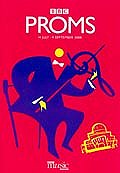 Concert Review
Concert Review
 Concert Review
Concert Review
PROM 60 Carl Ruggles - Sun-Treader, Schumann - Piano
Concerto in A minor; Stravinsky - The Rite of Spring. San Francisco SO /
Michael Tilson Thomas Martha Argerich, piano, 30 August 2000
(SD)
The Royal Albert Hall was completely packed, and the air of anticipation and suspended belief prevailed right up to the point of Martha Argerich's self-effacing arrival, and almost beyond it!
Tilson Thomas's appearance was hardly less welcome as he turned to the audience and gave a lively and witty recollection of Carl Ruggles and his methods of composition. The 16-minute Sun-treader (composed over a five year period) is one of no more than 10 or so pieces, minutely worked-over, which Ruggles produced in the course of 90 years. Like the composer, it is big and bold.
The tremendously powerful opening, with fff striding brass and pounding kettledrums, evokes the image of the giant-steps suggested to Ruggles by the 'Sun-treader' of Browning's paean to Shelley. It is a work of potent and dramatic contrasts, with sections of absolute steadiness set off by long-range accelerations, and 'roaring rhetoric' following serene lyricism. The San Francisco brass produced the most penetrating wall of sound throughout, and string articulation on the many cascading runs was impressive, as was the orchestra's general ensemble (notably in the sudden tacets). I sensed occasional uncertainty in the wind ensemble, though.
Next came the Schumann, and Argerich's subdued manner belied the strength of her playing of this warm, outspoken and virtuosic work. This typically mercurial, unpredictable performance had the audience on the edge of its seat throughout. Her first-movement Allegro affettuoso was surprisingly restrained - almost matter-of-fact - and the Andante expressivo very delicate, holding back for her furious rising scales in the Allegro. She and the clarinet played the coda with melting lyricism and heavy rubato, almost rêverie-like. The oboe didn't quite match her lyricism, however.
Almost catching Tilson Thomas unawares at the start of the second movement, she brought effortless grace to the music. The strings, seeming at first a bit sluggish in their response, soared into the upper reaches with great sensitivity, as she produced a breathtaking pppp on the lead into the finale. The piano was almost too quiet for the orchestra in the 3/4 against 3/2, but Argerich's crystalline scale passagework was delivered with hair-raising power and accuracy.
A hard act to follow, the San Francisco's Rite of Spring was highly polished and very exciting. Although we have grown used to it, the work's power to shock is still obvious. The wind excelled themselves in playing of amazing precision and sensitivity, including the bassoon's haunting introduction and the Slavic, heralding brass in 'Jeu du rapt'. The brass played with tremendous punch in the 'Danse de la terre' and the build-up of tension at the movement's close was powerful. Overall, a dazzling performance, though one which perhaps lacked the last ounce of sheer abandon.
Tilson Thomas couldn't resist a couple of encores - the March from Prokofiev's Love for Three Oranges and the 'Infernal Dance' from The Firebird. These were highly exciting, but almost gilded the lily.
Sarah Dunlop
Seen&Heard is part of Music on the Web(UK) Webmaster: Len Mullenger Len@musicweb-international.com
Return to: Seen&Heard Index
 Return to:
Music on the Web
Return to:
Music on the Web